BSMAN 3009: Accounting for Managers - Lehman Brothers Crisis Analysis
VerifiedAdded on 2021/09/14
|27
|4381
|109
Report
AI Summary
This report provides a detailed analysis of the financial crisis faced by Lehman Brothers, examining the company's background, major success factors, structural changes, causes of failure, and social impacts. It also summarizes the lessons learned from the crisis, including regulatory responses and the Dodd-Frank Act. Furthermore, the report includes a comprehensive analysis of the BCE Company, calculating and interpreting various financial ratios such as profitability, asset efficiency, liquidity, capital structure, and market performance ratios. The content covers the financial crisis of Lehman Brothers and ratio analysis for the BCE Company, offering valuable insights into financial management and accounting principles. The report is divided into two assessments, with the first focusing on the Lehman Brothers crisis and the second on the calculation and interpretation of financial ratios for the BCE Company.
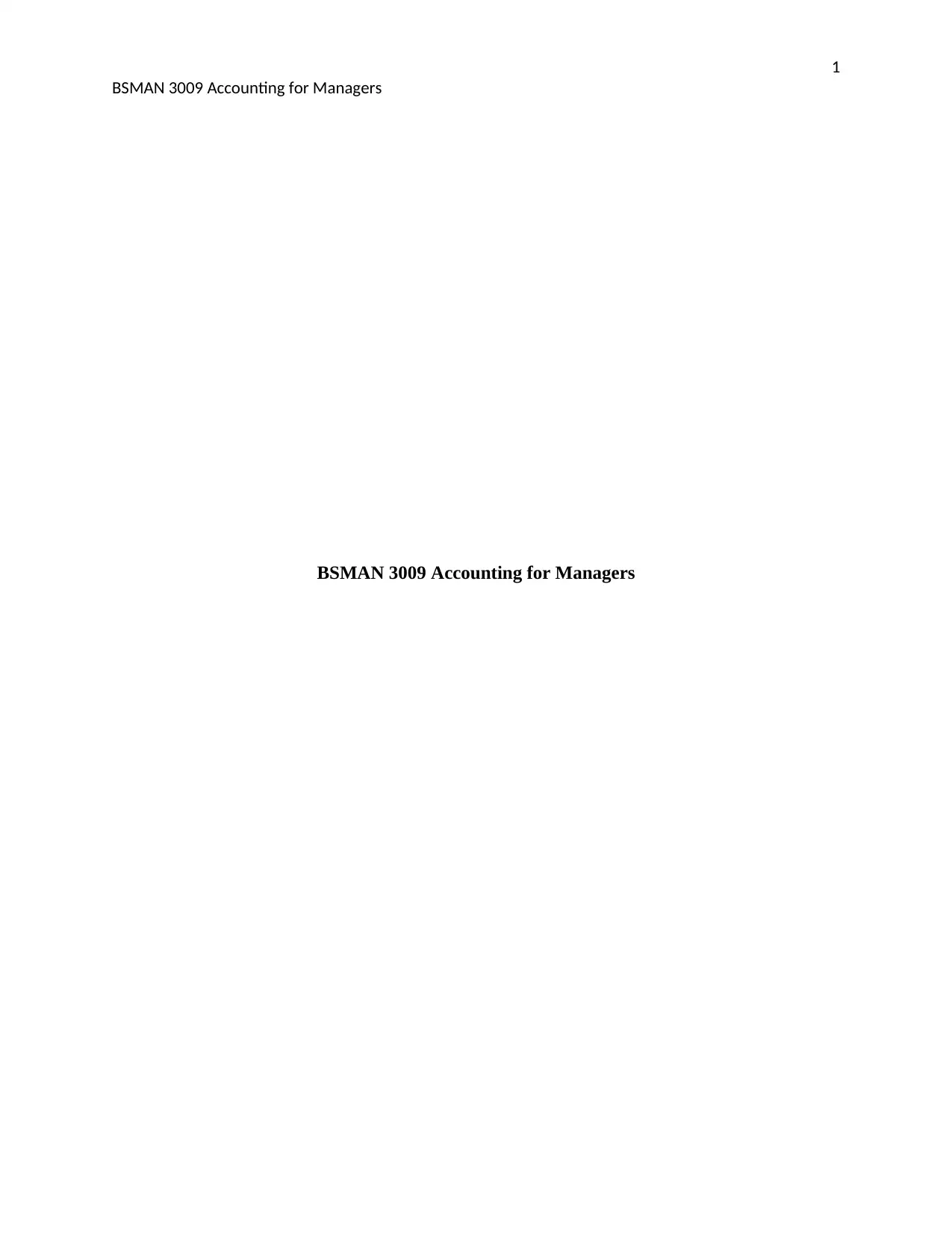
1
BSMAN 3009 Accounting for Managers
BSMAN 3009 Accounting for Managers
BSMAN 3009 Accounting for Managers
BSMAN 3009 Accounting for Managers
Paraphrase This Document
Need a fresh take? Get an instant paraphrase of this document with our AI Paraphraser
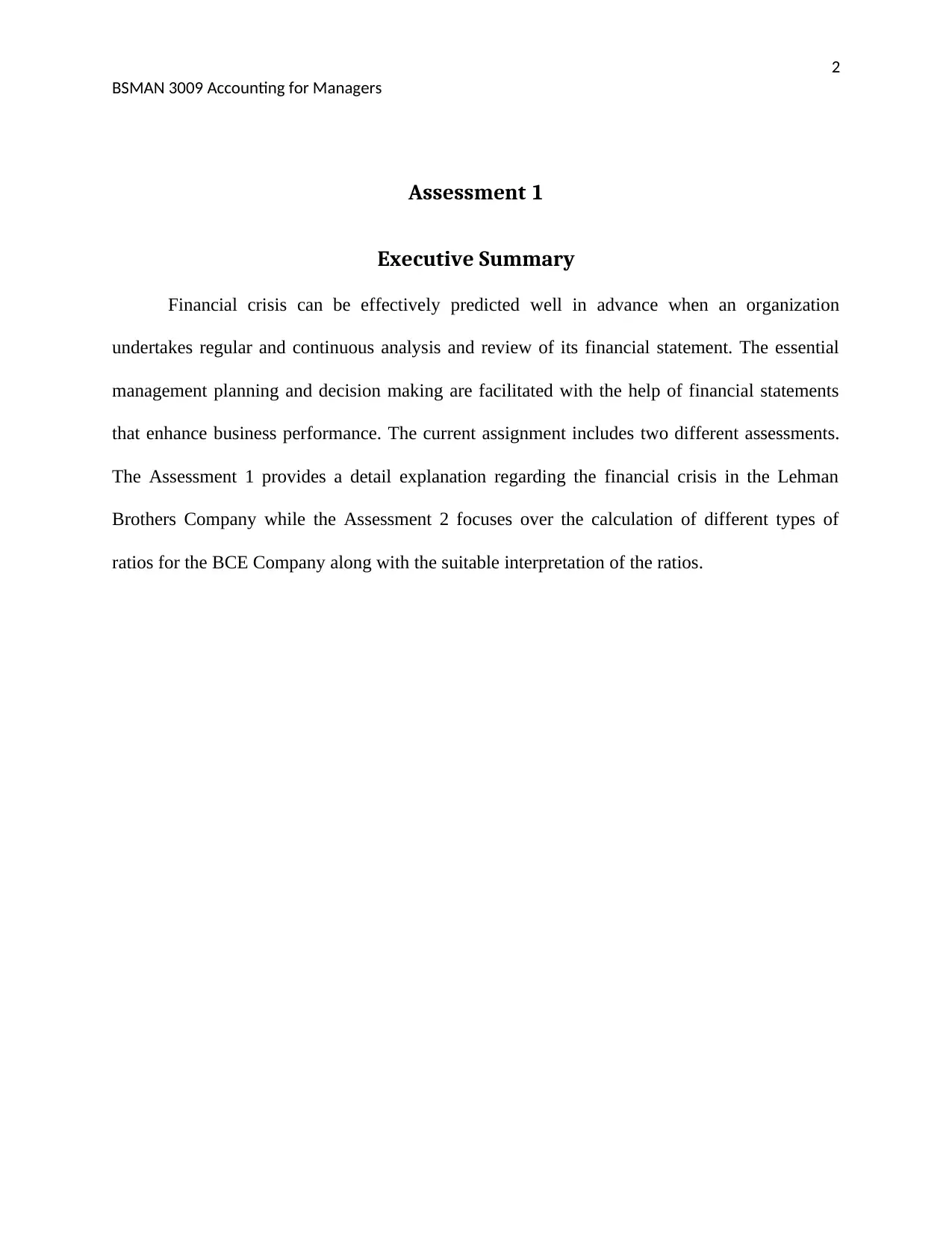
2
BSMAN 3009 Accounting for Managers
Assessment 1
Executive Summary
Financial crisis can be effectively predicted well in advance when an organization
undertakes regular and continuous analysis and review of its financial statement. The essential
management planning and decision making are facilitated with the help of financial statements
that enhance business performance. The current assignment includes two different assessments.
The Assessment 1 provides a detail explanation regarding the financial crisis in the Lehman
Brothers Company while the Assessment 2 focuses over the calculation of different types of
ratios for the BCE Company along with the suitable interpretation of the ratios.
BSMAN 3009 Accounting for Managers
Assessment 1
Executive Summary
Financial crisis can be effectively predicted well in advance when an organization
undertakes regular and continuous analysis and review of its financial statement. The essential
management planning and decision making are facilitated with the help of financial statements
that enhance business performance. The current assignment includes two different assessments.
The Assessment 1 provides a detail explanation regarding the financial crisis in the Lehman
Brothers Company while the Assessment 2 focuses over the calculation of different types of
ratios for the BCE Company along with the suitable interpretation of the ratios.
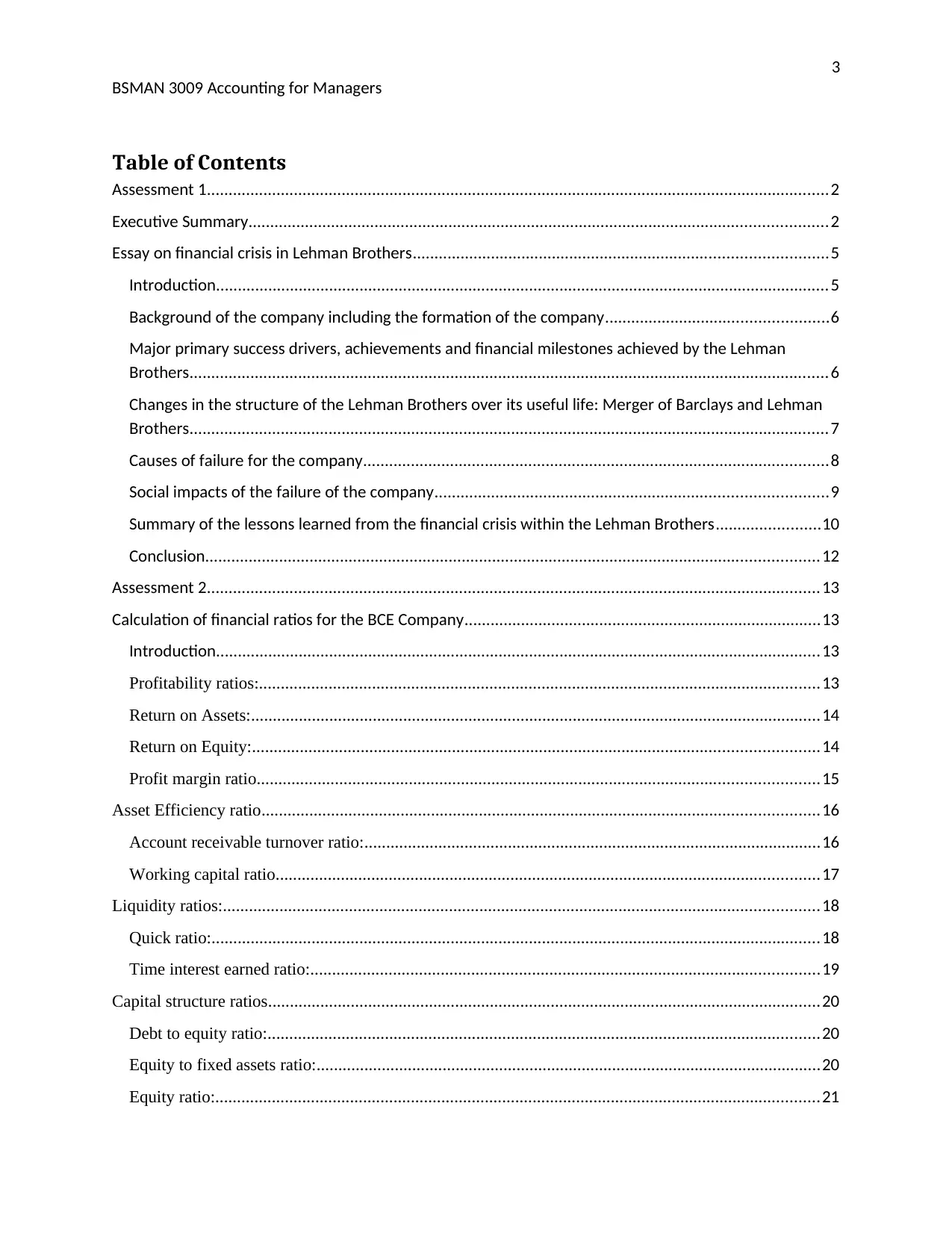
3
BSMAN 3009 Accounting for Managers
Table of Contents
Assessment 1...............................................................................................................................................2
Executive Summary.....................................................................................................................................2
Essay on financial crisis in Lehman Brothers...............................................................................................5
Introduction.............................................................................................................................................5
Background of the company including the formation of the company...................................................6
Major primary success drivers, achievements and financial milestones achieved by the Lehman
Brothers...................................................................................................................................................6
Changes in the structure of the Lehman Brothers over its useful life: Merger of Barclays and Lehman
Brothers...................................................................................................................................................7
Causes of failure for the company...........................................................................................................8
Social impacts of the failure of the company..........................................................................................9
Summary of the lessons learned from the financial crisis within the Lehman Brothers........................10
Conclusion.............................................................................................................................................12
Assessment 2.............................................................................................................................................13
Calculation of financial ratios for the BCE Company..................................................................................13
Introduction...........................................................................................................................................13
Profitability ratios:.................................................................................................................................13
Return on Assets:...................................................................................................................................14
Return on Equity:..................................................................................................................................14
Profit margin ratio.................................................................................................................................15
Asset Efficiency ratio................................................................................................................................16
Account receivable turnover ratio:.........................................................................................................16
Working capital ratio.............................................................................................................................17
Liquidity ratios:.........................................................................................................................................18
Quick ratio:............................................................................................................................................18
Time interest earned ratio:.....................................................................................................................19
Capital structure ratios...............................................................................................................................20
Debt to equity ratio:...............................................................................................................................20
Equity to fixed assets ratio:....................................................................................................................20
Equity ratio:...........................................................................................................................................21
BSMAN 3009 Accounting for Managers
Table of Contents
Assessment 1...............................................................................................................................................2
Executive Summary.....................................................................................................................................2
Essay on financial crisis in Lehman Brothers...............................................................................................5
Introduction.............................................................................................................................................5
Background of the company including the formation of the company...................................................6
Major primary success drivers, achievements and financial milestones achieved by the Lehman
Brothers...................................................................................................................................................6
Changes in the structure of the Lehman Brothers over its useful life: Merger of Barclays and Lehman
Brothers...................................................................................................................................................7
Causes of failure for the company...........................................................................................................8
Social impacts of the failure of the company..........................................................................................9
Summary of the lessons learned from the financial crisis within the Lehman Brothers........................10
Conclusion.............................................................................................................................................12
Assessment 2.............................................................................................................................................13
Calculation of financial ratios for the BCE Company..................................................................................13
Introduction...........................................................................................................................................13
Profitability ratios:.................................................................................................................................13
Return on Assets:...................................................................................................................................14
Return on Equity:..................................................................................................................................14
Profit margin ratio.................................................................................................................................15
Asset Efficiency ratio................................................................................................................................16
Account receivable turnover ratio:.........................................................................................................16
Working capital ratio.............................................................................................................................17
Liquidity ratios:.........................................................................................................................................18
Quick ratio:............................................................................................................................................18
Time interest earned ratio:.....................................................................................................................19
Capital structure ratios...............................................................................................................................20
Debt to equity ratio:...............................................................................................................................20
Equity to fixed assets ratio:....................................................................................................................20
Equity ratio:...........................................................................................................................................21
⊘ This is a preview!⊘
Do you want full access?
Subscribe today to unlock all pages.

Trusted by 1+ million students worldwide
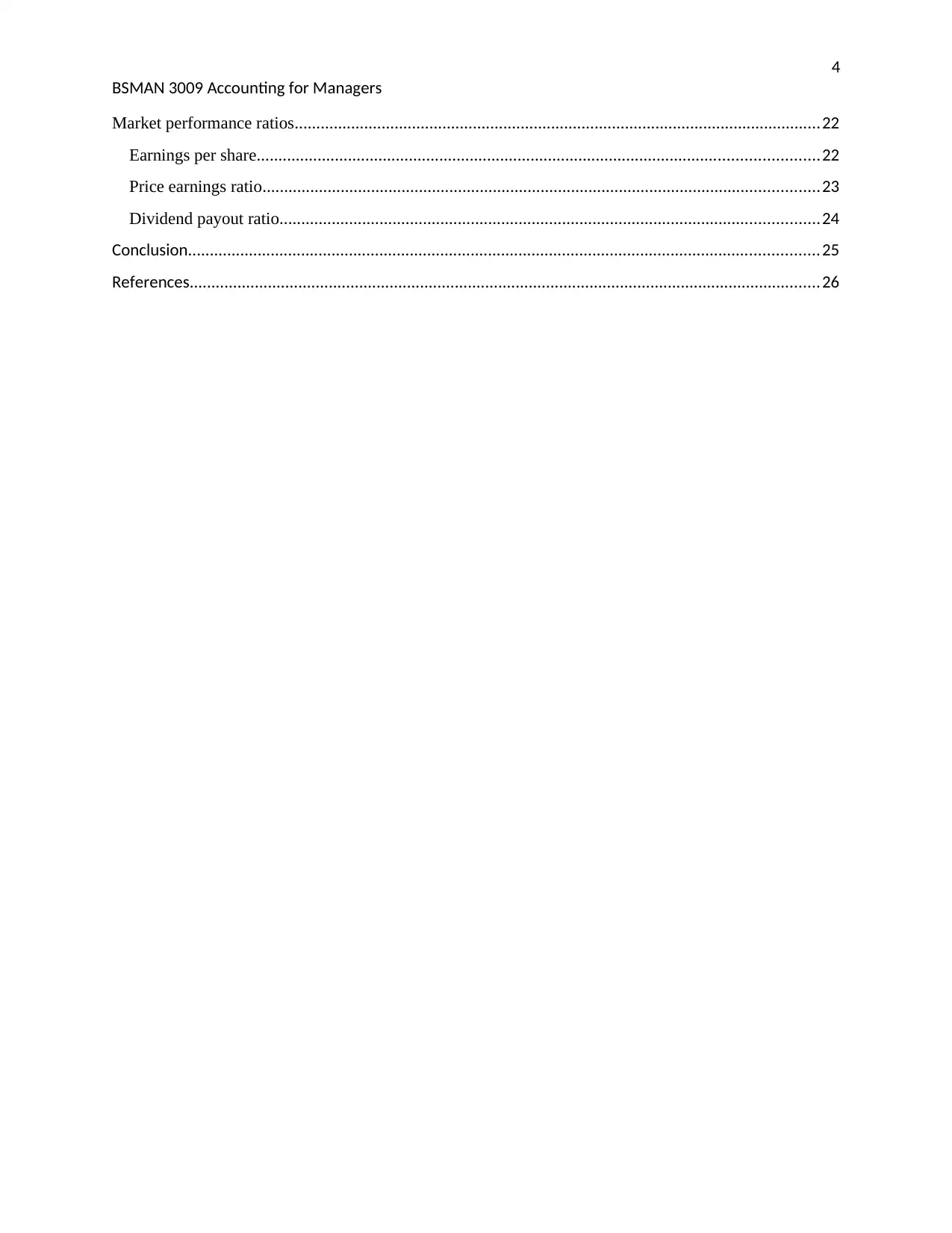
4
BSMAN 3009 Accounting for Managers
Market performance ratios.........................................................................................................................22
Earnings per share.................................................................................................................................22
Price earnings ratio................................................................................................................................23
Dividend payout ratio............................................................................................................................24
Conclusion.................................................................................................................................................25
References.................................................................................................................................................26
BSMAN 3009 Accounting for Managers
Market performance ratios.........................................................................................................................22
Earnings per share.................................................................................................................................22
Price earnings ratio................................................................................................................................23
Dividend payout ratio............................................................................................................................24
Conclusion.................................................................................................................................................25
References.................................................................................................................................................26
Paraphrase This Document
Need a fresh take? Get an instant paraphrase of this document with our AI Paraphraser

5
BSMAN 3009 Accounting for Managers
Essay on the financial crisis in Lehman Brothers
Introduction
The financial crisis is identified as a combination of diverse circumstances and situations
that result in the reduction in the nominal value of the financial assets of an organization. The
various causes that can be held responsible for the occurrence of a financial crisis can be global
recessions, crashing of the stock market, and reduction in the monetary value of currency along
with sovereign defaults. The current essay is a critical evaluation of a public listed organization
that has recently faced severe financial crises or has become insolvent in the last ten to fifteen
years. For the purpose of this assignment, Lehman Brothers Company has been chosen which is
a publicly listed under the New Stork Stock Exchange.
BSMAN 3009 Accounting for Managers
Essay on the financial crisis in Lehman Brothers
Introduction
The financial crisis is identified as a combination of diverse circumstances and situations
that result in the reduction in the nominal value of the financial assets of an organization. The
various causes that can be held responsible for the occurrence of a financial crisis can be global
recessions, crashing of the stock market, and reduction in the monetary value of currency along
with sovereign defaults. The current essay is a critical evaluation of a public listed organization
that has recently faced severe financial crises or has become insolvent in the last ten to fifteen
years. For the purpose of this assignment, Lehman Brothers Company has been chosen which is
a publicly listed under the New Stork Stock Exchange.
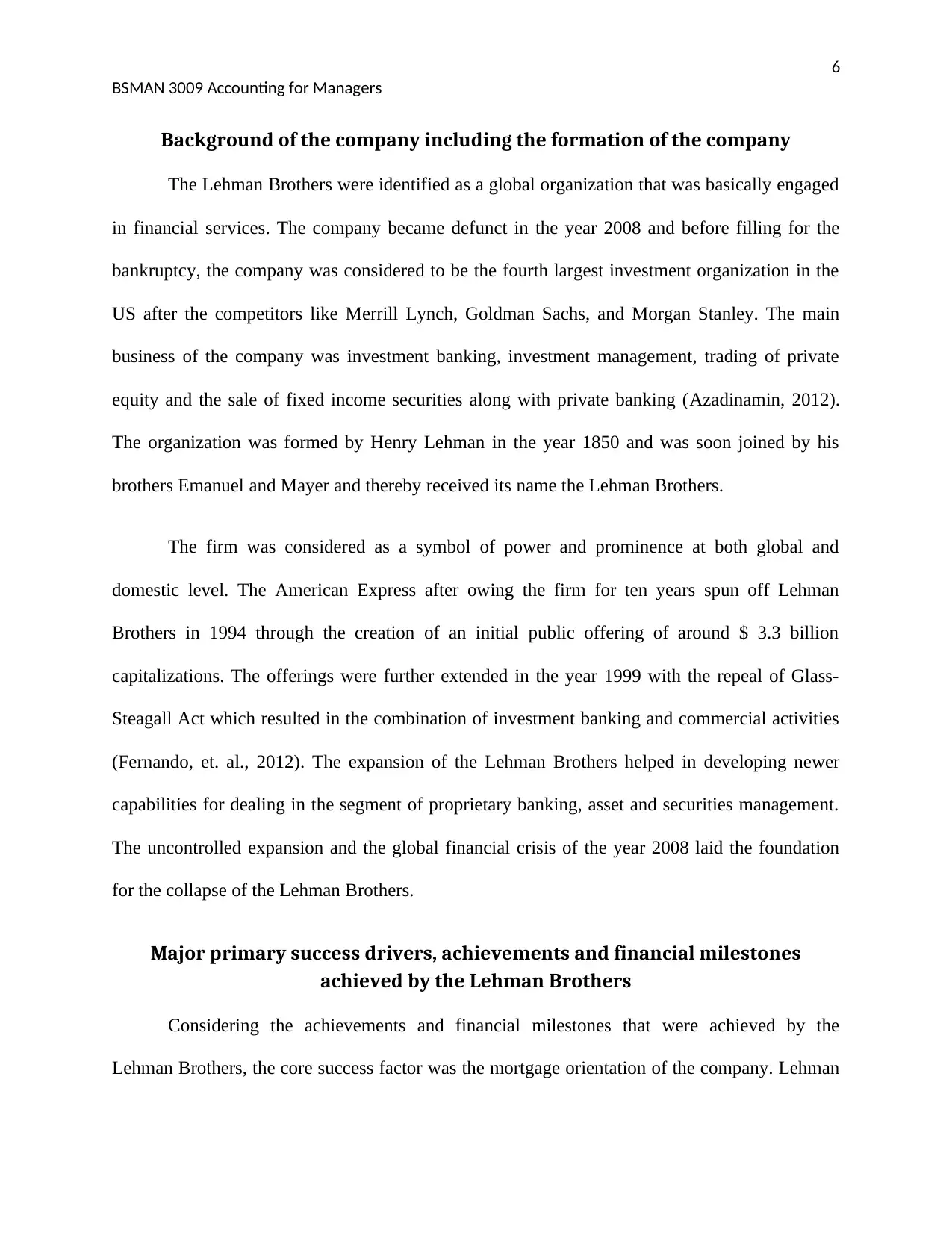
6
BSMAN 3009 Accounting for Managers
Background of the company including the formation of the company
The Lehman Brothers were identified as a global organization that was basically engaged
in financial services. The company became defunct in the year 2008 and before filling for the
bankruptcy, the company was considered to be the fourth largest investment organization in the
US after the competitors like Merrill Lynch, Goldman Sachs, and Morgan Stanley. The main
business of the company was investment banking, investment management, trading of private
equity and the sale of fixed income securities along with private banking (Azadinamin, 2012).
The organization was formed by Henry Lehman in the year 1850 and was soon joined by his
brothers Emanuel and Mayer and thereby received its name the Lehman Brothers.
The firm was considered as a symbol of power and prominence at both global and
domestic level. The American Express after owing the firm for ten years spun off Lehman
Brothers in 1994 through the creation of an initial public offering of around $ 3.3 billion
capitalizations. The offerings were further extended in the year 1999 with the repeal of Glass-
Steagall Act which resulted in the combination of investment banking and commercial activities
(Fernando, et. al., 2012). The expansion of the Lehman Brothers helped in developing newer
capabilities for dealing in the segment of proprietary banking, asset and securities management.
The uncontrolled expansion and the global financial crisis of the year 2008 laid the foundation
for the collapse of the Lehman Brothers.
Major primary success drivers, achievements and financial milestones
achieved by the Lehman Brothers
Considering the achievements and financial milestones that were achieved by the
Lehman Brothers, the core success factor was the mortgage orientation of the company. Lehman
BSMAN 3009 Accounting for Managers
Background of the company including the formation of the company
The Lehman Brothers were identified as a global organization that was basically engaged
in financial services. The company became defunct in the year 2008 and before filling for the
bankruptcy, the company was considered to be the fourth largest investment organization in the
US after the competitors like Merrill Lynch, Goldman Sachs, and Morgan Stanley. The main
business of the company was investment banking, investment management, trading of private
equity and the sale of fixed income securities along with private banking (Azadinamin, 2012).
The organization was formed by Henry Lehman in the year 1850 and was soon joined by his
brothers Emanuel and Mayer and thereby received its name the Lehman Brothers.
The firm was considered as a symbol of power and prominence at both global and
domestic level. The American Express after owing the firm for ten years spun off Lehman
Brothers in 1994 through the creation of an initial public offering of around $ 3.3 billion
capitalizations. The offerings were further extended in the year 1999 with the repeal of Glass-
Steagall Act which resulted in the combination of investment banking and commercial activities
(Fernando, et. al., 2012). The expansion of the Lehman Brothers helped in developing newer
capabilities for dealing in the segment of proprietary banking, asset and securities management.
The uncontrolled expansion and the global financial crisis of the year 2008 laid the foundation
for the collapse of the Lehman Brothers.
Major primary success drivers, achievements and financial milestones
achieved by the Lehman Brothers
Considering the achievements and financial milestones that were achieved by the
Lehman Brothers, the core success factor was the mortgage orientation of the company. Lehman
⊘ This is a preview!⊘
Do you want full access?
Subscribe today to unlock all pages.

Trusted by 1+ million students worldwide
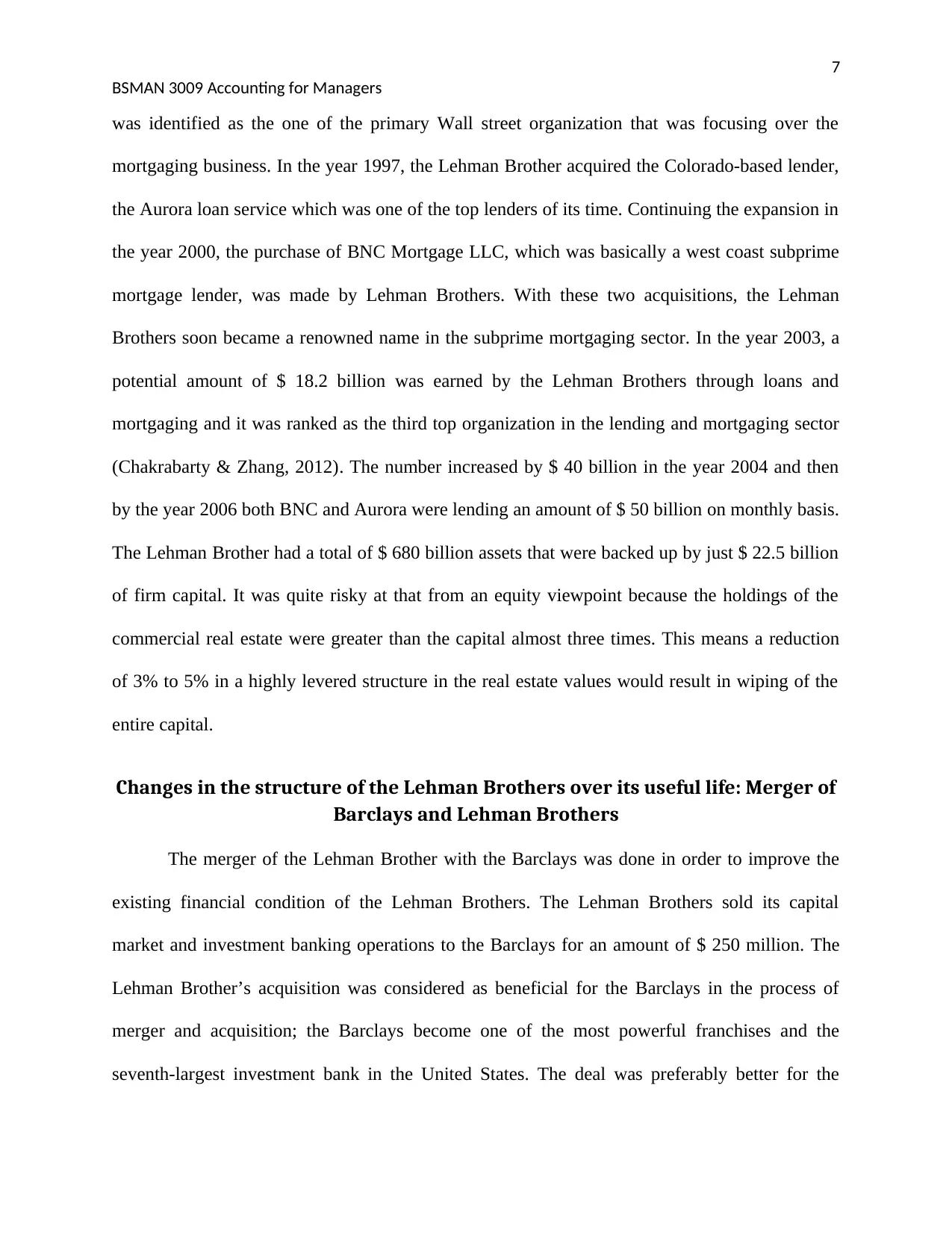
7
BSMAN 3009 Accounting for Managers
was identified as the one of the primary Wall street organization that was focusing over the
mortgaging business. In the year 1997, the Lehman Brother acquired the Colorado-based lender,
the Aurora loan service which was one of the top lenders of its time. Continuing the expansion in
the year 2000, the purchase of BNC Mortgage LLC, which was basically a west coast subprime
mortgage lender, was made by Lehman Brothers. With these two acquisitions, the Lehman
Brothers soon became a renowned name in the subprime mortgaging sector. In the year 2003, a
potential amount of $ 18.2 billion was earned by the Lehman Brothers through loans and
mortgaging and it was ranked as the third top organization in the lending and mortgaging sector
(Chakrabarty & Zhang, 2012). The number increased by $ 40 billion in the year 2004 and then
by the year 2006 both BNC and Aurora were lending an amount of $ 50 billion on monthly basis.
The Lehman Brother had a total of $ 680 billion assets that were backed up by just $ 22.5 billion
of firm capital. It was quite risky at that from an equity viewpoint because the holdings of the
commercial real estate were greater than the capital almost three times. This means a reduction
of 3% to 5% in a highly levered structure in the real estate values would result in wiping of the
entire capital.
Changes in the structure of the Lehman Brothers over its useful life: Merger of
Barclays and Lehman Brothers
The merger of the Lehman Brother with the Barclays was done in order to improve the
existing financial condition of the Lehman Brothers. The Lehman Brothers sold its capital
market and investment banking operations to the Barclays for an amount of $ 250 million. The
Lehman Brother’s acquisition was considered as beneficial for the Barclays in the process of
merger and acquisition; the Barclays become one of the most powerful franchises and the
seventh-largest investment bank in the United States. The deal was preferably better for the
BSMAN 3009 Accounting for Managers
was identified as the one of the primary Wall street organization that was focusing over the
mortgaging business. In the year 1997, the Lehman Brother acquired the Colorado-based lender,
the Aurora loan service which was one of the top lenders of its time. Continuing the expansion in
the year 2000, the purchase of BNC Mortgage LLC, which was basically a west coast subprime
mortgage lender, was made by Lehman Brothers. With these two acquisitions, the Lehman
Brothers soon became a renowned name in the subprime mortgaging sector. In the year 2003, a
potential amount of $ 18.2 billion was earned by the Lehman Brothers through loans and
mortgaging and it was ranked as the third top organization in the lending and mortgaging sector
(Chakrabarty & Zhang, 2012). The number increased by $ 40 billion in the year 2004 and then
by the year 2006 both BNC and Aurora were lending an amount of $ 50 billion on monthly basis.
The Lehman Brother had a total of $ 680 billion assets that were backed up by just $ 22.5 billion
of firm capital. It was quite risky at that from an equity viewpoint because the holdings of the
commercial real estate were greater than the capital almost three times. This means a reduction
of 3% to 5% in a highly levered structure in the real estate values would result in wiping of the
entire capital.
Changes in the structure of the Lehman Brothers over its useful life: Merger of
Barclays and Lehman Brothers
The merger of the Lehman Brother with the Barclays was done in order to improve the
existing financial condition of the Lehman Brothers. The Lehman Brothers sold its capital
market and investment banking operations to the Barclays for an amount of $ 250 million. The
Lehman Brother’s acquisition was considered as beneficial for the Barclays in the process of
merger and acquisition; the Barclays become one of the most powerful franchises and the
seventh-largest investment bank in the United States. The deal was preferably better for the
Paraphrase This Document
Need a fresh take? Get an instant paraphrase of this document with our AI Paraphraser
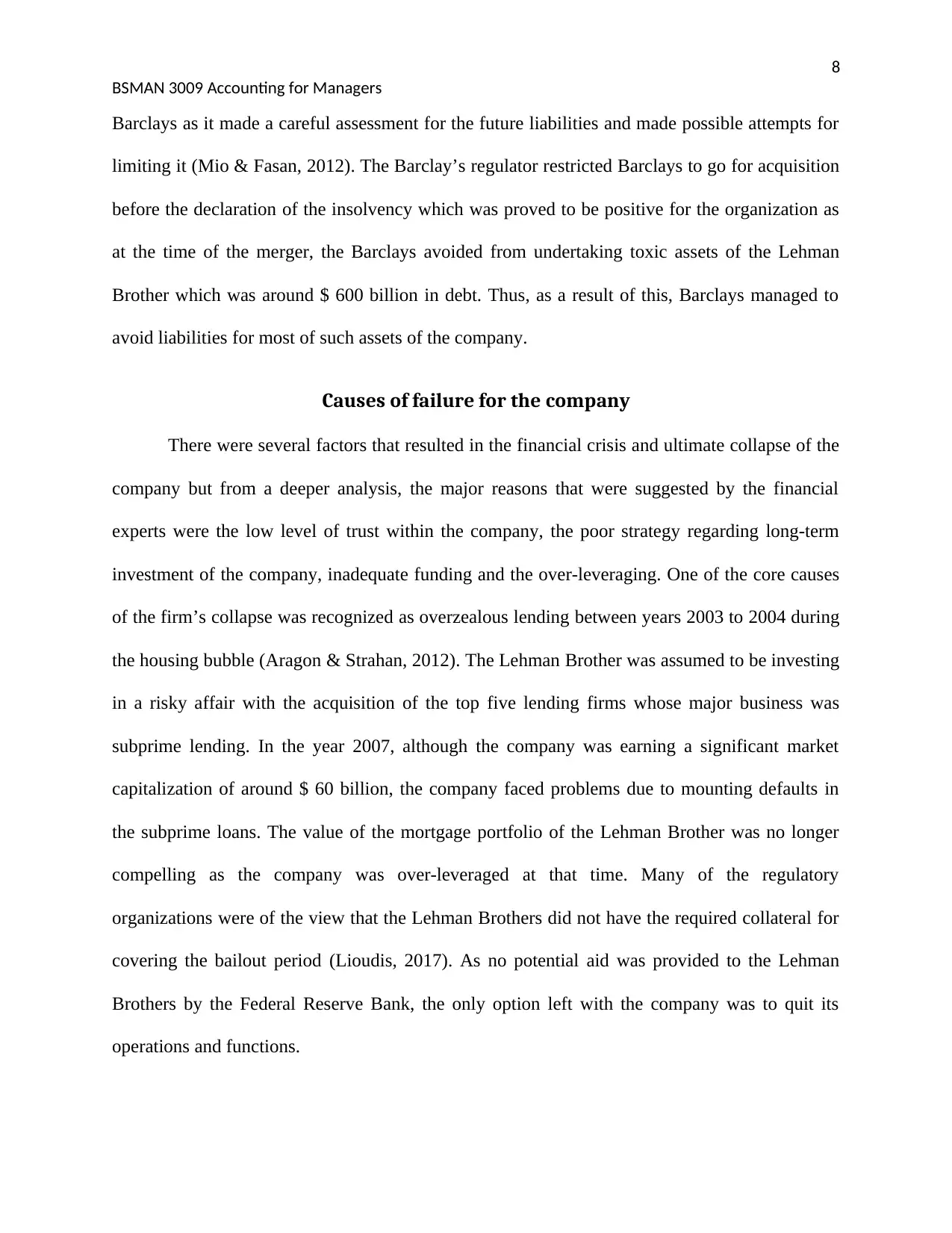
8
BSMAN 3009 Accounting for Managers
Barclays as it made a careful assessment for the future liabilities and made possible attempts for
limiting it (Mio & Fasan, 2012). The Barclay’s regulator restricted Barclays to go for acquisition
before the declaration of the insolvency which was proved to be positive for the organization as
at the time of the merger, the Barclays avoided from undertaking toxic assets of the Lehman
Brother which was around $ 600 billion in debt. Thus, as a result of this, Barclays managed to
avoid liabilities for most of such assets of the company.
Causes of failure for the company
There were several factors that resulted in the financial crisis and ultimate collapse of the
company but from a deeper analysis, the major reasons that were suggested by the financial
experts were the low level of trust within the company, the poor strategy regarding long-term
investment of the company, inadequate funding and the over-leveraging. One of the core causes
of the firm’s collapse was recognized as overzealous lending between years 2003 to 2004 during
the housing bubble (Aragon & Strahan, 2012). The Lehman Brother was assumed to be investing
in a risky affair with the acquisition of the top five lending firms whose major business was
subprime lending. In the year 2007, although the company was earning a significant market
capitalization of around $ 60 billion, the company faced problems due to mounting defaults in
the subprime loans. The value of the mortgage portfolio of the Lehman Brother was no longer
compelling as the company was over-leveraged at that time. Many of the regulatory
organizations were of the view that the Lehman Brothers did not have the required collateral for
covering the bailout period (Lioudis, 2017). As no potential aid was provided to the Lehman
Brothers by the Federal Reserve Bank, the only option left with the company was to quit its
operations and functions.
BSMAN 3009 Accounting for Managers
Barclays as it made a careful assessment for the future liabilities and made possible attempts for
limiting it (Mio & Fasan, 2012). The Barclay’s regulator restricted Barclays to go for acquisition
before the declaration of the insolvency which was proved to be positive for the organization as
at the time of the merger, the Barclays avoided from undertaking toxic assets of the Lehman
Brother which was around $ 600 billion in debt. Thus, as a result of this, Barclays managed to
avoid liabilities for most of such assets of the company.
Causes of failure for the company
There were several factors that resulted in the financial crisis and ultimate collapse of the
company but from a deeper analysis, the major reasons that were suggested by the financial
experts were the low level of trust within the company, the poor strategy regarding long-term
investment of the company, inadequate funding and the over-leveraging. One of the core causes
of the firm’s collapse was recognized as overzealous lending between years 2003 to 2004 during
the housing bubble (Aragon & Strahan, 2012). The Lehman Brother was assumed to be investing
in a risky affair with the acquisition of the top five lending firms whose major business was
subprime lending. In the year 2007, although the company was earning a significant market
capitalization of around $ 60 billion, the company faced problems due to mounting defaults in
the subprime loans. The value of the mortgage portfolio of the Lehman Brother was no longer
compelling as the company was over-leveraged at that time. Many of the regulatory
organizations were of the view that the Lehman Brothers did not have the required collateral for
covering the bailout period (Lioudis, 2017). As no potential aid was provided to the Lehman
Brothers by the Federal Reserve Bank, the only option left with the company was to quit its
operations and functions.
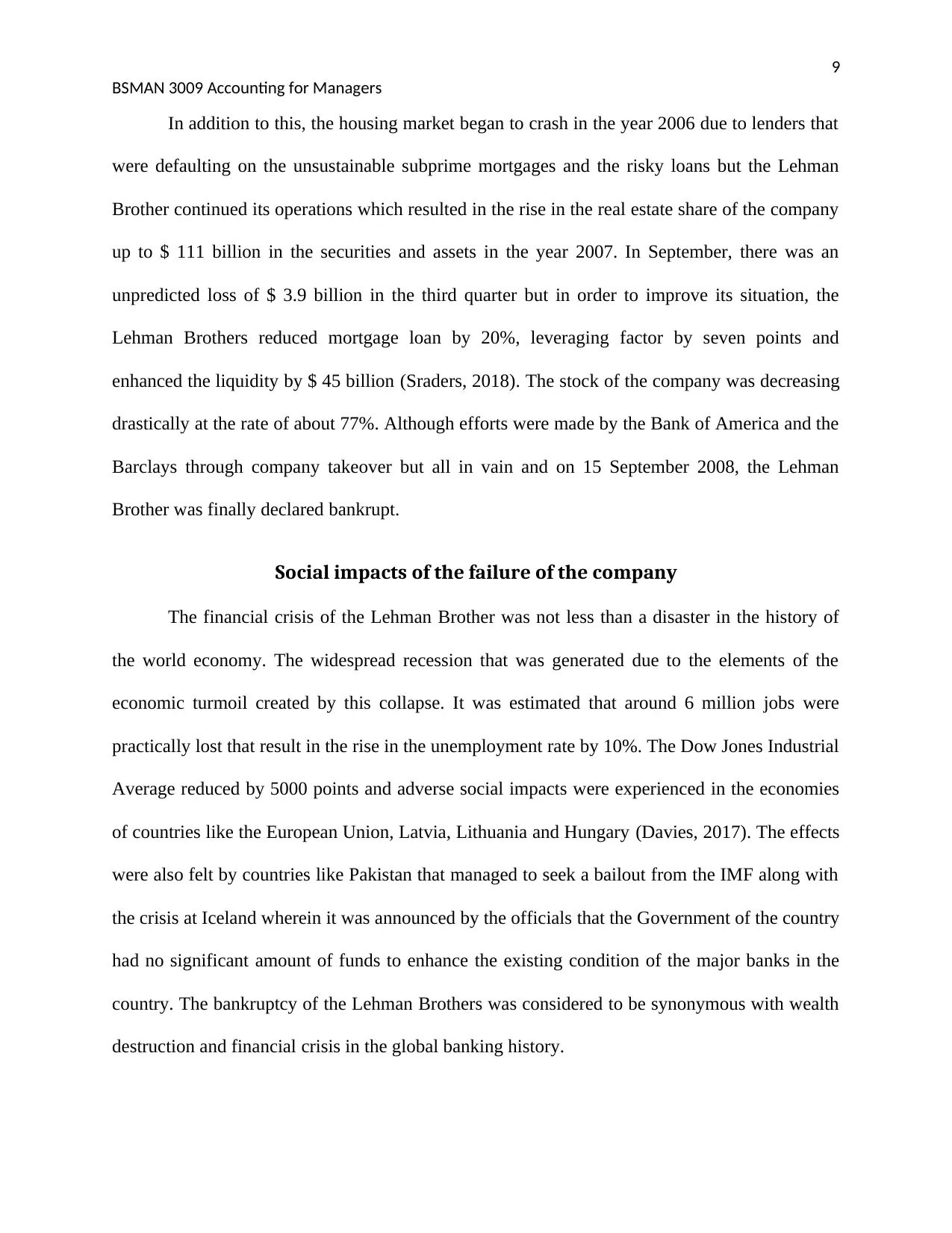
9
BSMAN 3009 Accounting for Managers
In addition to this, the housing market began to crash in the year 2006 due to lenders that
were defaulting on the unsustainable subprime mortgages and the risky loans but the Lehman
Brother continued its operations which resulted in the rise in the real estate share of the company
up to $ 111 billion in the securities and assets in the year 2007. In September, there was an
unpredicted loss of $ 3.9 billion in the third quarter but in order to improve its situation, the
Lehman Brothers reduced mortgage loan by 20%, leveraging factor by seven points and
enhanced the liquidity by $ 45 billion (Sraders, 2018). The stock of the company was decreasing
drastically at the rate of about 77%. Although efforts were made by the Bank of America and the
Barclays through company takeover but all in vain and on 15 September 2008, the Lehman
Brother was finally declared bankrupt.
Social impacts of the failure of the company
The financial crisis of the Lehman Brother was not less than a disaster in the history of
the world economy. The widespread recession that was generated due to the elements of the
economic turmoil created by this collapse. It was estimated that around 6 million jobs were
practically lost that result in the rise in the unemployment rate by 10%. The Dow Jones Industrial
Average reduced by 5000 points and adverse social impacts were experienced in the economies
of countries like the European Union, Latvia, Lithuania and Hungary (Davies, 2017). The effects
were also felt by countries like Pakistan that managed to seek a bailout from the IMF along with
the crisis at Iceland wherein it was announced by the officials that the Government of the country
had no significant amount of funds to enhance the existing condition of the major banks in the
country. The bankruptcy of the Lehman Brothers was considered to be synonymous with wealth
destruction and financial crisis in the global banking history.
BSMAN 3009 Accounting for Managers
In addition to this, the housing market began to crash in the year 2006 due to lenders that
were defaulting on the unsustainable subprime mortgages and the risky loans but the Lehman
Brother continued its operations which resulted in the rise in the real estate share of the company
up to $ 111 billion in the securities and assets in the year 2007. In September, there was an
unpredicted loss of $ 3.9 billion in the third quarter but in order to improve its situation, the
Lehman Brothers reduced mortgage loan by 20%, leveraging factor by seven points and
enhanced the liquidity by $ 45 billion (Sraders, 2018). The stock of the company was decreasing
drastically at the rate of about 77%. Although efforts were made by the Bank of America and the
Barclays through company takeover but all in vain and on 15 September 2008, the Lehman
Brother was finally declared bankrupt.
Social impacts of the failure of the company
The financial crisis of the Lehman Brother was not less than a disaster in the history of
the world economy. The widespread recession that was generated due to the elements of the
economic turmoil created by this collapse. It was estimated that around 6 million jobs were
practically lost that result in the rise in the unemployment rate by 10%. The Dow Jones Industrial
Average reduced by 5000 points and adverse social impacts were experienced in the economies
of countries like the European Union, Latvia, Lithuania and Hungary (Davies, 2017). The effects
were also felt by countries like Pakistan that managed to seek a bailout from the IMF along with
the crisis at Iceland wherein it was announced by the officials that the Government of the country
had no significant amount of funds to enhance the existing condition of the major banks in the
country. The bankruptcy of the Lehman Brothers was considered to be synonymous with wealth
destruction and financial crisis in the global banking history.
⊘ This is a preview!⊘
Do you want full access?
Subscribe today to unlock all pages.

Trusted by 1+ million students worldwide
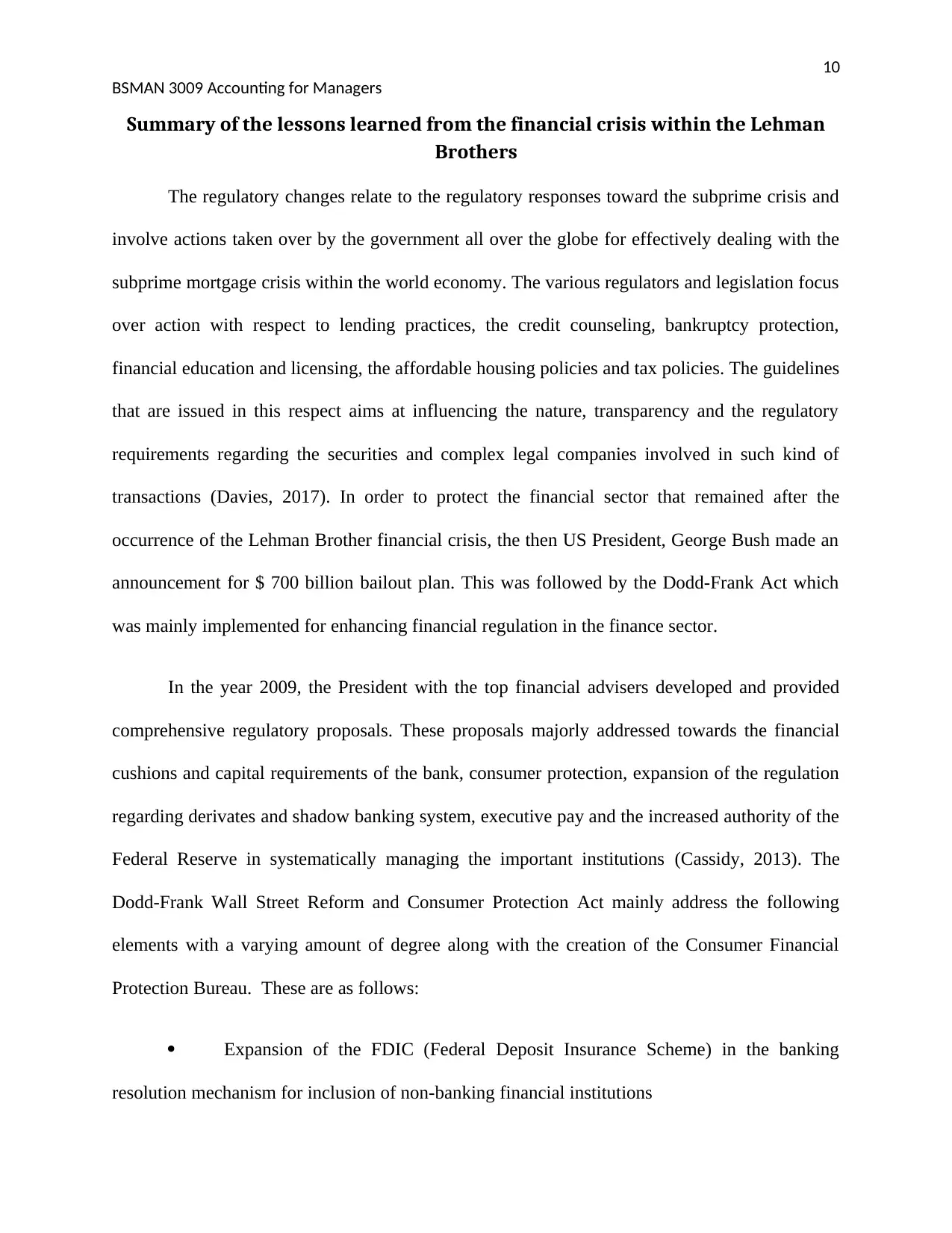
10
BSMAN 3009 Accounting for Managers
Summary of the lessons learned from the financial crisis within the Lehman
Brothers
The regulatory changes relate to the regulatory responses toward the subprime crisis and
involve actions taken over by the government all over the globe for effectively dealing with the
subprime mortgage crisis within the world economy. The various regulators and legislation focus
over action with respect to lending practices, the credit counseling, bankruptcy protection,
financial education and licensing, the affordable housing policies and tax policies. The guidelines
that are issued in this respect aims at influencing the nature, transparency and the regulatory
requirements regarding the securities and complex legal companies involved in such kind of
transactions (Davies, 2017). In order to protect the financial sector that remained after the
occurrence of the Lehman Brother financial crisis, the then US President, George Bush made an
announcement for $ 700 billion bailout plan. This was followed by the Dodd-Frank Act which
was mainly implemented for enhancing financial regulation in the finance sector.
In the year 2009, the President with the top financial advisers developed and provided
comprehensive regulatory proposals. These proposals majorly addressed towards the financial
cushions and capital requirements of the bank, consumer protection, expansion of the regulation
regarding derivates and shadow banking system, executive pay and the increased authority of the
Federal Reserve in systematically managing the important institutions (Cassidy, 2013). The
Dodd-Frank Wall Street Reform and Consumer Protection Act mainly address the following
elements with a varying amount of degree along with the creation of the Consumer Financial
Protection Bureau. These are as follows:
Expansion of the FDIC (Federal Deposit Insurance Scheme) in the banking
resolution mechanism for inclusion of non-banking financial institutions
BSMAN 3009 Accounting for Managers
Summary of the lessons learned from the financial crisis within the Lehman
Brothers
The regulatory changes relate to the regulatory responses toward the subprime crisis and
involve actions taken over by the government all over the globe for effectively dealing with the
subprime mortgage crisis within the world economy. The various regulators and legislation focus
over action with respect to lending practices, the credit counseling, bankruptcy protection,
financial education and licensing, the affordable housing policies and tax policies. The guidelines
that are issued in this respect aims at influencing the nature, transparency and the regulatory
requirements regarding the securities and complex legal companies involved in such kind of
transactions (Davies, 2017). In order to protect the financial sector that remained after the
occurrence of the Lehman Brother financial crisis, the then US President, George Bush made an
announcement for $ 700 billion bailout plan. This was followed by the Dodd-Frank Act which
was mainly implemented for enhancing financial regulation in the finance sector.
In the year 2009, the President with the top financial advisers developed and provided
comprehensive regulatory proposals. These proposals majorly addressed towards the financial
cushions and capital requirements of the bank, consumer protection, expansion of the regulation
regarding derivates and shadow banking system, executive pay and the increased authority of the
Federal Reserve in systematically managing the important institutions (Cassidy, 2013). The
Dodd-Frank Wall Street Reform and Consumer Protection Act mainly address the following
elements with a varying amount of degree along with the creation of the Consumer Financial
Protection Bureau. These are as follows:
Expansion of the FDIC (Federal Deposit Insurance Scheme) in the banking
resolution mechanism for inclusion of non-banking financial institutions
Paraphrase This Document
Need a fresh take? Get an instant paraphrase of this document with our AI Paraphraser
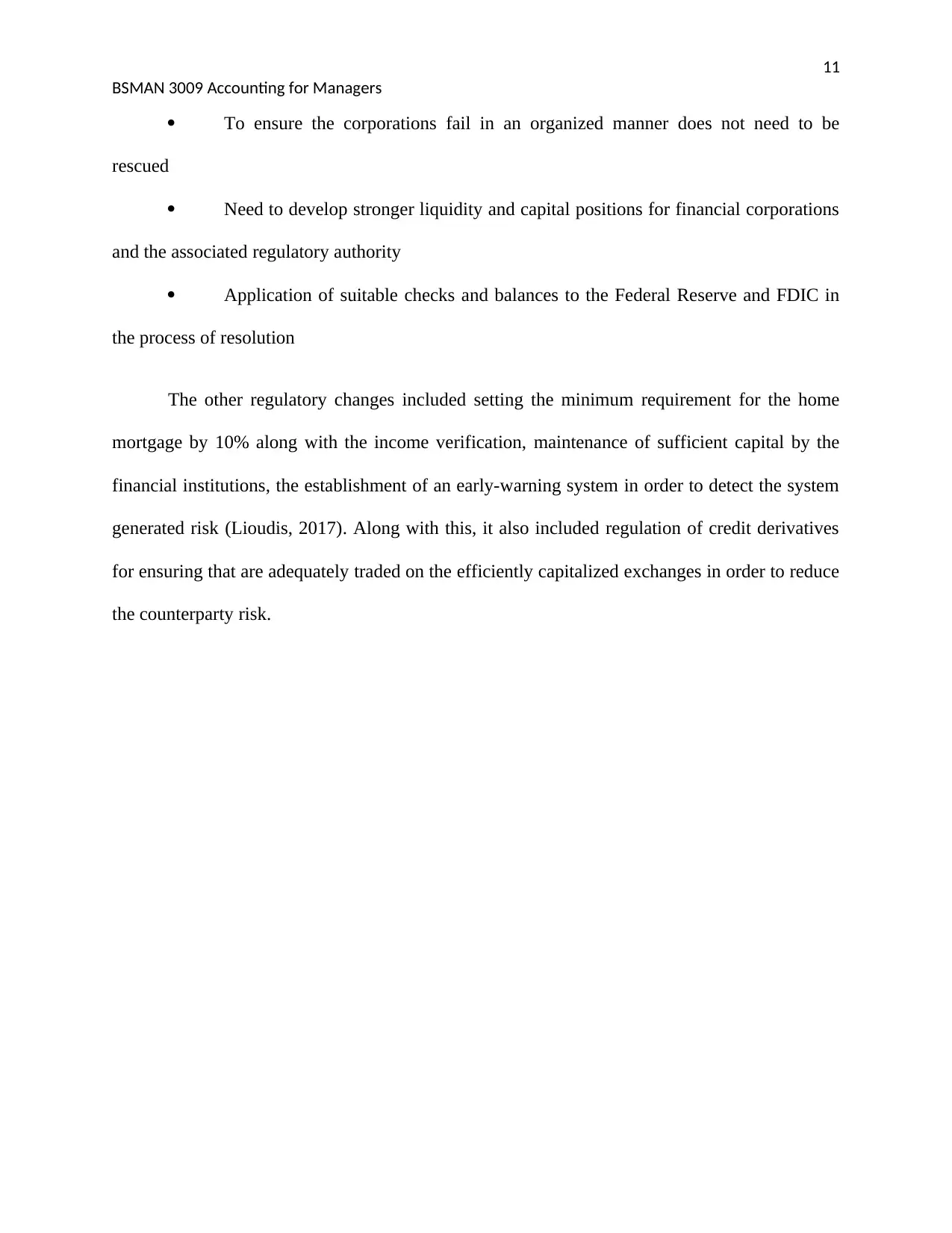
11
BSMAN 3009 Accounting for Managers
To ensure the corporations fail in an organized manner does not need to be
rescued
Need to develop stronger liquidity and capital positions for financial corporations
and the associated regulatory authority
Application of suitable checks and balances to the Federal Reserve and FDIC in
the process of resolution
The other regulatory changes included setting the minimum requirement for the home
mortgage by 10% along with the income verification, maintenance of sufficient capital by the
financial institutions, the establishment of an early-warning system in order to detect the system
generated risk (Lioudis, 2017). Along with this, it also included regulation of credit derivatives
for ensuring that are adequately traded on the efficiently capitalized exchanges in order to reduce
the counterparty risk.
BSMAN 3009 Accounting for Managers
To ensure the corporations fail in an organized manner does not need to be
rescued
Need to develop stronger liquidity and capital positions for financial corporations
and the associated regulatory authority
Application of suitable checks and balances to the Federal Reserve and FDIC in
the process of resolution
The other regulatory changes included setting the minimum requirement for the home
mortgage by 10% along with the income verification, maintenance of sufficient capital by the
financial institutions, the establishment of an early-warning system in order to detect the system
generated risk (Lioudis, 2017). Along with this, it also included regulation of credit derivatives
for ensuring that are adequately traded on the efficiently capitalized exchanges in order to reduce
the counterparty risk.
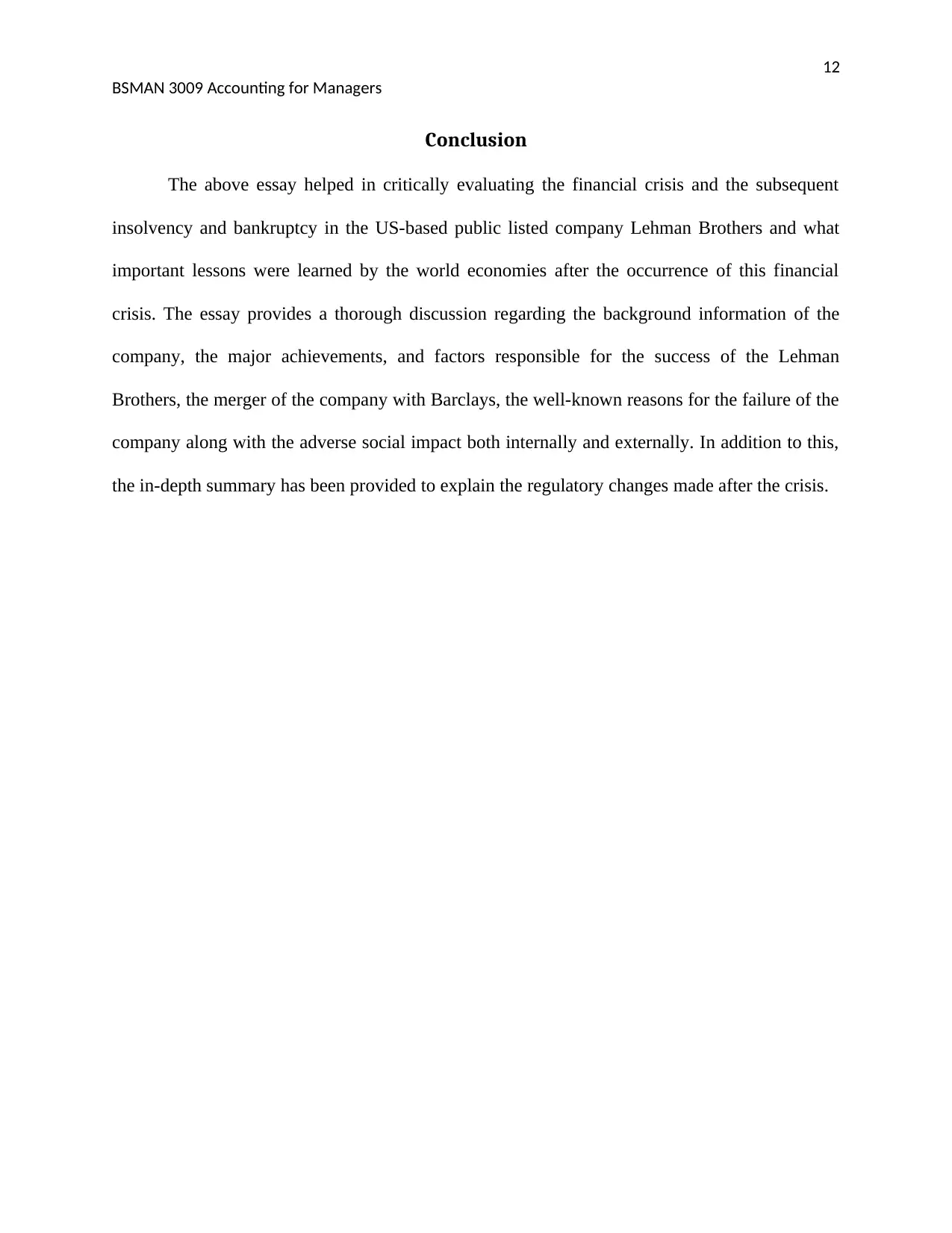
12
BSMAN 3009 Accounting for Managers
Conclusion
The above essay helped in critically evaluating the financial crisis and the subsequent
insolvency and bankruptcy in the US-based public listed company Lehman Brothers and what
important lessons were learned by the world economies after the occurrence of this financial
crisis. The essay provides a thorough discussion regarding the background information of the
company, the major achievements, and factors responsible for the success of the Lehman
Brothers, the merger of the company with Barclays, the well-known reasons for the failure of the
company along with the adverse social impact both internally and externally. In addition to this,
the in-depth summary has been provided to explain the regulatory changes made after the crisis.
BSMAN 3009 Accounting for Managers
Conclusion
The above essay helped in critically evaluating the financial crisis and the subsequent
insolvency and bankruptcy in the US-based public listed company Lehman Brothers and what
important lessons were learned by the world economies after the occurrence of this financial
crisis. The essay provides a thorough discussion regarding the background information of the
company, the major achievements, and factors responsible for the success of the Lehman
Brothers, the merger of the company with Barclays, the well-known reasons for the failure of the
company along with the adverse social impact both internally and externally. In addition to this,
the in-depth summary has been provided to explain the regulatory changes made after the crisis.
⊘ This is a preview!⊘
Do you want full access?
Subscribe today to unlock all pages.

Trusted by 1+ million students worldwide
1 out of 27
Related Documents
Your All-in-One AI-Powered Toolkit for Academic Success.
+13062052269
info@desklib.com
Available 24*7 on WhatsApp / Email
![[object Object]](/_next/static/media/star-bottom.7253800d.svg)
Unlock your academic potential
Copyright © 2020–2025 A2Z Services. All Rights Reserved. Developed and managed by ZUCOL.





